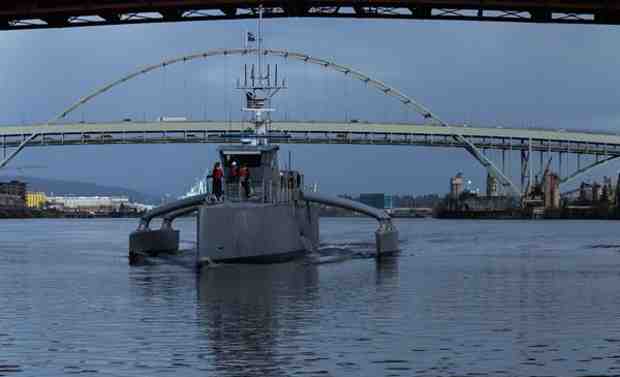U.S. Makes Robot Warship to Show Human-Machine Collaboration
Sea Hunter, a robot warship designed and built by the Defense Advanced Research Projects Agency (DARPA), represents breakthroughs in autonomous navigation and human-machine collaboration that could change the nature of U.S. maritime operations, deputy defense secretary Bob Work said Thursday.
Work spoke during a dockside ceremony just before DARPA director Arati Prabhakar christened the vessel Sea Hunter, a name that describes the planned capabilities of the 130-foot twin-screw trimaran — a boat with a main hull and two smaller outrigger hulls.
“I’ve been waiting for this day for a long time,” Work told the audience.
DARPA developed and built the technology-demonstration vessel through its anti-submarine warfare continuous-trail unmanned vessel, or ACTUV, program.
The new class of oceangoing vessel can travel thousands of kilometers over open seas for months at a time without crewmembers, but always with remote human supervision, according to a DARPA news release about the ship.
[ Panasonic Assist Robots to Help Workers and the Elderly ]
Potential missions initially will include submarine tracking and countermine activities, Prabhakar said during a media briefing after the ceremony.
At-sea testing on a surrogate ship has shown that Sea Hunter’s autonomous navigation software can operate the ship in compliance with maritime laws and conventions for safe navigation, including the 1972 International Regulations for Preventing Collisions at Sea published by the International Maritime Organization to prevent collisions between two or more vessels, the release said.
Sea Hunter follows these rules using advanced software and hardware that act as automated lookouts, allowing the ship to operate safely near manned maritime vessels in all weather and traffic conditions, day or night, according to the release.
[ Visit and Support RMN Foundation Free Schools for Children ]
To test the ACTUV prototype, DARPA signed a memorandum of agreement in September 2014 with the Office of Naval Research (ONR) to jointly fund an extended test phase. DARPA officials said they will collaborate with ONR to fully test the capabilities of the vessel and several payloads during open-water testing.
Testing is scheduled to begin this summer off the California coast after a preliminary checkout and movement to San Diego. If it is successful, the program could transition to the Navy by 2018, DARPA says.
During an interview on the way to Portland Wednesday, Work called the Sea Hunter and its capabilities an inflection point.
The completely robotic ship has a range of 10,000 nautical miles at 12 knots and the prototype cost $23 million to produce, the deputy secretary said. After it’s been tested and multiple ships are produced, it will cost about $15,000 to $20,000 a day to operate, he added.
This is in contrast to the $600,000 cost to operate a manned helicopter for 24 hours, or $700,000 to operate a destroyer for the same amount of time, Work noted.
In the picture above: Sea Hunter, a prototype of a new class of unmanned oceangoing vessel, conducts on-water tests in Portland, Ore., recently. The Defense Advanced Research Projects Agency held a christening ceremony for the ship April 7, 2016, in Portland. DoD photo













